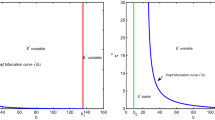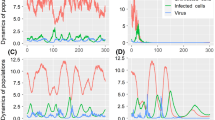Abstract
The present work studies models of oncolytic virotherapy without space variable in which virus replication occurs at a faster time scale than tumor growth. We address the questions of the modeling of virus injection in this slow–fast system and of the optimal timing for different treatment strategies. To this aim, we first derive the asymptotic of a three-species slow–fast model and obtain a two-species dynamical system, where the variables are tumor cells and infected tumor cells. We fully characterize the behavior of this system depending on the various biological parameters. In the second part, we address the modeling of virus injection and its expression in the two-species system, where the amount of virus does not appear explicitly. We prove that the injection can be described by an instantaneous jump in the phase plane, where a certain amount of tumors cells are transformed instantly into infected tumor cells. This description allows discussing qualitatively the timing of different injections in the frame of successive treatment strategies. This work is illustrated by numerical simulations. The timing and amount of injected virus may have counterintuitive optimal values; nevertheless, the understanding is clear from the phase space analysis.










Similar content being viewed by others
References
Bajzer Ž, Carr T, Josić K, Russell SJ, Dingli D (2008) Modeling of cancer virotherapy with recombinant measles viruses. J Theor Biol 252(1):109–122
Biesecker M, Kimn J-H, Lu H, Dingli D, Bajzer Ž (2010) Optimization of virotherapy for cancer. Bull Math Biol 72(2):469–489
Byrne HM, Cox SM, Kelly C (2004) Macrophage–tumour interactions: in vivo dynamics. Discrete Contin Dyn Syst B 4(1):81
Dingli D, Offord C, Myers R, Peng K-W, Carr T, Josic K, Russell SJ, Bajzer Z (2009) Dynamics of multiple myeloma tumor therapy with a recombinant measles virus. Cancer Gene Ther 16(12):873–882
Jenner AL, Yun C-O, Kim PS, Coster AC (2018a) Mathematical modelling of the interaction between cancer cells and an oncolytic virus: insights into the effects of treatment protocols. Bull Math Biol 80(6):1615–1629
Jenner AL, Coster AC, Kim PS, Frascoli F (2018b) Treating cancerous cells with viruses: insights from a minimal model for oncolytic virotherapy. Lett Biomath 5(sup1):117–136
Kelly E, Russell SJ (2007) History of oncolytic viruses: genesis to genetic engineering. Mol Ther 15(4):651–659
Kuznetsov YA (1998) Elements of applied bifurcation theory, 2nd edn. Springer, Berlin, Heidelberg
Levin J, Levinson N (1954) Singular perturbations of non-linear systems of differential equations and an associated boundary layer equation. J Ration Mech Anal 3:247–270
Murphy H, Jaafari H, Dobrovolny HM (2016) Differences in predictions of ode models of tumor growth: a cautionary example. BMC Cancer 16(1):1–10
Novozhilov AS, Berezovskaya FS, Koonin EV, Karev GP (2006) Mathematical modeling of tumor therapy with oncolytic viruses: regimes with complete tumor elimination within the framework of deterministic models. Biol Direct 1(1):1–18
Paiva LR, Binny C, Ferreira SC, Martins ML (2009) A multiscale mathematical model for oncolytic virotherapy. Can Res 69(3):1205–1211
Ratajczyk E, Ledzewicz U, Schättler H (2018) Optimal control for a mathematical model of glioma treatment with oncolytic therapy and tnf-\(\alpha \) inhibitors. J Optim Theory Appl 176(2):456–477
Rodriguez-Brenes IA, Hofacre A, Fan H, Wodarz D (2017) Complex dynamics of virus spread from low infection multiplicities: implications for the spread of oncolytic viruses. PLoS Comput Biol 13(1):1005241
Ruf B, Lauer UM (2015) Assessment of current virotherapeutic application schemes: ‘hit hard and early’ versus “killing softly”. Mol Ther Oncol 2:15018
Santiago D, Heidbuechel J, Kandell W, Walker R, Djeu J, Engeland C, Abate-Daga D, Enderling H (2017) Fighting cancer with mathematics and viruses. Viruses 9:239
Titze MI, Frank J, Ehrhardt M, Smola S, Graf N, Lehr T (2017) A generic viral dynamic model to systematically characterize the interaction between oncolytic virus kinetics and tumor growth. Eur J Pharm Sci 97:38–46
Wodarz D (2001) Viruses as antitumor weapons: defining conditions for tumor remission. Can Res 61(8):3501–3507
Wodarz D (2003) Gene therapy for killing p53-negative cancer cells: use of replicating versus nonreplicating agents. Hum Gene Ther 14(2):153–159
Wodarz D, Komarova N (2009) Towards predictive computational models of oncolytic virus therapy: basis for experimental validation and model selection. PLoS ONE 4(1):4271
Wu JT, Byrne HM, Kirn DH, Wein LM (2001) Modeling and analysis of a virus that replicates selectively in tumor cells. Bull Math Biol 63(4):731–768
Author information
Authors and Affiliations
Corresponding author
Additional information
Publisher's Note
Springer Nature remains neutral with regard to jurisdictional claims in published maps and institutional affiliations.
A Proofs
A Proofs
1.1 A.1 Proof of Proposition 2 (Stability of Equilibria)
Proof
The fact that the system admits only the three equilibria \((0,0), (1,0), (x^*,y^*)\) follows from a simple computation. We now study the stability of these equilibria.
Equilibrium (0, 0) The Jacobian matrix is given by:
it is a saddle equilibrium. The only possibility to converge toward this equilibrium is to follow its stable manifold, which is the line \(x=0\). In other words, all cancer cells are infected.
Equilibrium (1, 0) The Jacobian matrix is given by:
This equilibrium is a saddle if \(N-{1} > \beta \), and for \(N-{1} < \beta \) it is stable.
Endemic equilibrium The Jacobian matrix is given by:
The determinant is positive for \(N>1\) since \(x^*<1\). Moreover, the trace is negative if and only if
Therefore, the endemic equilibrium is stable if \(\beta >\beta _c=\dfrac{N-1}{N+1}\) and unstable if \(\beta <\beta _c\). \(\square \)
1.2 A.2 Proof of Proposition 3 (Hopf Bifurcation Analysis)
Proof
We follow the approach proposed in Kuznetsov (1998). Let us study the following orbitally equivalent system obtained by changing the time parametrization:
The equilibrium of interest is:
The Jacobian matrix of the system in \((x^*,y^*)\) for \(\beta =\beta _c\) is:
Its eigenvalues are \(i\omega \) and \(-i\omega \) with
The following two eigenvectors p and q are such that \(Aq=i\omega q\), \(A^Tp=-i\omega p\) and \(\langle p,q\rangle =1\):
The system in the appropriate basis is approximated by:
where
and
Finally, it remains to compute
The computations lead to
The first Lyapunov exponent is then given by:
The first Lyapunov exponent is thus negative; therefore, the unique and stable limit cycle bifurcates from the equilibrium via a supercritical Hopf bifurcation for \(\beta <\beta _c\). \(\square \)
1.3 A.3: Treatment Approximation
Proof of Proposition 4
We consider the solutions \((X_0, Y_0, Z_0) \) of the first-order system (8):
with initial conditions \(X_0(0)=0=Y_0(0)\) and \(Z_0(0)=V>0\).
Since \(Y_0'(u)= -X_0'(u)\), it suffices to study the couple \((X_0,Z_0)\). From the last equation, we deduce that \(Z_0(u)>0\) for all \(u\ge 0\). Similarly, we obtain that \(X_0(u)+x_0(t_0)>0\) for all \(u\ge 0\). Thus, we deduce that
This leads to
As a consequence \(Z_0(u)\rightarrow 0\) as \(u\rightarrow \infty \). Let us now remark that
and therefore by integration
From (11), we deduce that \(X_0\) converges as \(u\rightarrow \infty \) toward a negative limit
Moreover, it follows from \(X_0'(u)=-\lambda (x_0(t_0)+X_0(u))Z_0(u)\) and Duhamel’s formula that
By letting \(u\rightarrow \infty \) and using the fact that \(\displaystyle \int _0^\infty Z_0(s){\mathrm{d}}s=\dfrac{V-Q}{\delta }\), one sees that Q satifies the following implicit equation:
\(\square \)
Proof of Theorem 1
\({\hbox {Step 1: Prove that the solutions of}}\) (8) \(\hbox {are close approximations of} (X, Y,Z).\)
To do so, we first study the regularity of the solutions of (7) with respect to the parameter \(\epsilon \) as a parameter. Let us denote by G the function \({\mathbf {R}}\times {\mathbf {R}}^3\times {\mathbf {R}}\rightarrow {\mathbf {R}}^3\) such that the system (7) reads
To study the dependency in \(\epsilon \), we consider the extended system for a fixed value \(\epsilon _0>0\)
Let us denote by \(u\mapsto \psi (u,(0,0,V,\epsilon _0))\) the flow associated with this differential equation, and then, our aim is to control
where \(\widetilde{G}(s,(X,Y,Z,\epsilon ))=(G(s,X,Y,Z,\epsilon ),0)\). If \(\widetilde{G}\) has bounded derivatives with respect to its second variable, then there exists a positive constant L such that
which leads using the Grönwall lemma to
\({\mathrm{Step 2: Regularity of} \widetilde{G}.}\)
We recall that:
Clearly, \(\widetilde{G}\) is smooth, but its derivative is not uniformly bounded. We now prove that the trajectories remain in a compact set, where \(\widetilde{G}\) has thus bounded derivatives.
Let us first prove that the solutions \((x_\epsilon , y_\epsilon ,z_\epsilon )\) of (2) are bounded uniformly in time, by a constant that depends only on the initial condition (and not on \(\epsilon \)). Clearly, all coordinates remain positive. The upper bound can be obtain since \(x_\epsilon \) has a logistic behavior, and \(x_\epsilon +y_\epsilon \) has negative derivative if \(y_\epsilon \ge \frac{\mu }{\lambda }x_\epsilon (1-x_\epsilon )\) and \(z_\epsilon \) has negative derivative as soon as \(z_\epsilon \ge \frac{N\gamma y_\epsilon }{\delta +\lambda x_\epsilon }\). A similar argument shows that the solutions (X, Y, Z) of (8) are uniformly bounded through times and for \(\epsilon \) in some compact \([0,\epsilon _{max}]\). This allows to obtain (13).
\({\mathrm{Step 3: Conclusion}}\) Finally combining (13) and (9), if \((X_\epsilon ,Y_\epsilon ,Z_\epsilon )\) denote the solution of (7) for a given value of \(\epsilon \), we obtain:
Let us fix \(A>0\), and then, for a time \(u_\epsilon =-\frac{1}{\delta }ln(\epsilon ^A\delta /V)\), we have that
In particular, if A satisfies that \(1-AL/\delta >0\), then it comes
which leads as \(\epsilon u_\epsilon \rightarrow 0\) to
Similarly, we have that
To conclude, let us prove that \(\lim _{\epsilon \rightarrow 0}\bar{z}_\epsilon (t_0+\epsilon u_\epsilon )\) is finite. The naive bound given by (13) is not sufficient to conclude since \(u_\epsilon \rightarrow \infty \) and
Therefore, let us come back to the exact ODE satisfied by \(Z_\epsilon \):
From the previous computations, we have that on the time interval \([0, u_\epsilon ]\), there exists a positive constant M independent of \(\epsilon \) such that
As a consequence for all \(u\in [0, u_\epsilon ]\)
Using this upper bound and the fact that \(\bar{z}_\epsilon \) remains positive for all times, we deduce that
remains bounded as \(\epsilon \rightarrow 0\). We finally use Theorem 1.2 from Levin and Levinson (1954) on the solutions of singularly perturbed differential equations to conclude that for any \(T>t>t_0\), the solution \((\bar{x}_\epsilon , \bar{y}_\epsilon )\) are asymptotically equal to the solution of the system (5) starting from \((x_0-Q,y_0+Q)\) on the interval [t, T]. \(\square \)
Rights and permissions
About this article
Cite this article
Cordelier, P., Costa, M. & Fehrenbach, J. Slow–Fast Model and Therapy Optimization for Oncolytic Treatment of Tumors. Bull Math Biol 84, 64 (2022). https://doi.org/10.1007/s11538-022-01025-3
Received:
Accepted:
Published:
DOI: https://doi.org/10.1007/s11538-022-01025-3




